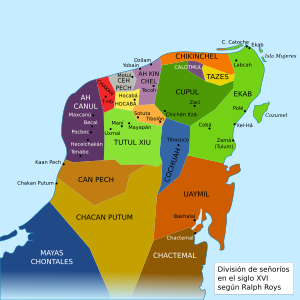Chikinchel
- View a machine-translated version of the Spanish article.
- Machine translation, like DeepL or Google Translate, is a useful starting point for translations, but translators must revise errors as necessary and confirm that the translation is accurate, rather than simply copy-pasting machine-translated text into the English Wikipedia.
- Do not translate text that appears unreliable or low-quality. If possible, verify the text with references provided in the foreign-language article.
- You must provide copyright attribution in the edit summary accompanying your translation by providing an interlanguage link to the source of your translation. A model attribution edit summary is
Content in this edit is translated from the existing Spanish Wikipedia article at [[:es:Chikinchel]]; see its history for attribution. - You may also add the template
{{Translated|es|Chikinchel}}to the talk page. - For more guidance, see Wikipedia:Translation.

Chikinchel (Yucatec Maya: Chikinchel de Chinkín) was the name of a Mayan chiefdom of the northern coast of Yucatán, before the arrival of the Spanish conquistadors in the sixteenth century.[1] Chauacá has also been used to refer to this province, but apparently it was the name of the main city.
After the destruction of Mayapan (1441–1461), in the Yucatán Peninsula, it created rivalries among the Maya, and formed 16 separate jurisdictions, called Kuchkabals. In each Kuchkabal there was a Halach Uinik (Yucatec Maya: Halach Uinik), who was the chief with the most political, judicial, and militaristic authority and lived in a principal city considered the capital of the jurisdiction.
Historical Dates and Territories
It bordered the Tazes and Cupul in the south, Ah Kin Chel in the west, and Ekab in the east, which separated an area of swamps and, to the north, a large portion of the coast of the Yucatán Peninsula. The area provided an abundance of animals to hunt and salt and salt to mine (it was the leading producer on the peninsula), although unhealthy conditions caused dignitaries to live in remote villages along the coast.
Chikinchel does not appear to have been a united providence. Chauaca fought frequently with local rivals, like Sinsimato and Dzonotaké.[2] However, salt united the inhabitants of the jurisdiction because they prevented outsiders from Ah Kin Chel and the south from going where valuable chloride was produced.
References
- ^ Kepecs, Susan (1999). The political economy of Chikinchel, Yucatán, Mexico: a diachronic analysis from the prehispanic era through the age of Spanish administration. University of Wisconsin--Madison. Retrieved 5 July 2012.
- ^ Salas, Angel (2005). Northeastern Yucatan Project: Archaeological Survey in the Northeastern Corner of Yucatan, Mexico (PDF). Retrieved 29 May 2016.
- v
- t
- e











